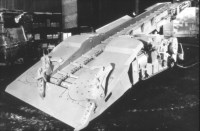|
Blue Heron, or Mine 18, came late to the Stearns mines and was electrified from the beginning, but was not mechanized in 1937. Gone were the small mules hauling coal cars out of the mine shafts, but men still used pick and shovel and carbide lights on their hats before the days of battery pack lights. During the hand loading days, men were paid by the number, putting a tag of each coal car they loaded. At the end of the shift, a man’s tonnage would be tallied. Some men remember loading as much as twelve or fifteen tons of coal a day. In the early days they got less than sixty cents a ton for loading coal. 
National Park Service The most often mentioned change for mining at Blue Heron, was the addition of the "Joy" loader which changed the way of processing coal from the mine, assigning work and paying the men. The "Joy", so named for the company that produced it looked something like a scorpion, and scooped the coal that had been cut or shot down from the coal wall onto a conveyor to be loaded into shuttle cars which took it out of the mine to mine cars. With the passing of hand loading, miners were no longer paid by the ton but by the shift, and where a man was assigned the mines no longer dictated how much money he could make. It was the age of the hourly or daily wage. At the beginning of mining at 18, great quantities of #1 coal were expected. Stearns Company, however, did no core drilling to test the height or extent of the coal seam. Mine 18 played out early with even #2 coal, much higher in sulfur, in short supply with seams only around 32 inches in height on average. Some say that Justus mine was the mine that Blue Heron should have been. Others say that the Company kept the Blue Heron mines going to keep people employed, but kept losing money on the operation. Listen to the men who worked deep in the mines.
To continue your visit through the Blue Heron Mining Community, choose the next "ghost structure" you wish to visit.
|
Last updated: April 14, 2015
